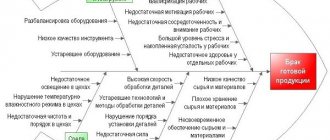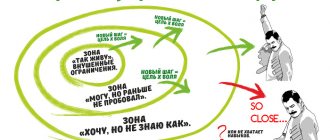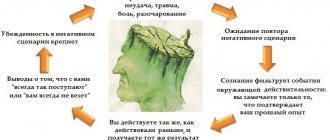Writing informative and useful articles is not such an easy task. Before writing the material, it is important to do some preparatory work. Even experienced, professional writers always make a small plan. You can't do without it. In this article I will tell you in detail how to create a text plan. Knowing how to write a plan is an extremely useful skill. Thanks to him, even before writing the material, it is already clear what information needs to be displayed in the article. It is a kind of skeleton. Relying on it, the author will never miss important information or forget to write it. In my training on how to make a website with your own hands, I pay special attention to the correct preparation of articles. After all, they are the tool that attracts visitors to the site. And if the articles are written according to all the rules, they will definitely interest users. Which will have a positive impact on resource traffic and the earnings of its owner. I often get asked the same question. Where to start writing an article. And I always answer - from the plan! In order not to talk about the same thing again and again, I decided to prepare a detailed explanation.
For your information! If you want to make a website with your own hands absolutely free, sign up for my training. There is no need to pay to participate!
LeaderTask Scheduler
- Your data is always at hand
- Allows any rearrangement of tasks
- Transfer dates
- Planning for the day, week, month and more
- Reminders
- Creating any categories for the plan
- Tasks in Focus
- Tags: important, urgent, attention
- Color coding of tasks
- Deleting tasks
- Task completion status
- Transferring tasks with “Overdue” status
- Regular reminders
- Attaching files, links, images
- Additional changes
Another example of compilation
Let's choose a creative topic for the article - drawing portraits.
Heading:
How to learn to draw portraits and cartoons using the dry brush technique
If the plan is ready, but there is a problem with the title for the text, then here is an excellent article on writing titles, with templates and examples on my blog.
Introduction:
The ability to draw black and white and color portraits using the dry brush technique will allow you to earn big money. This article will tell you how to do this.
There is also a good article on introduction that will help you with this matter.
Content
- Drawing tools
- Where to buy special paper and paint
- Portrait sketch
- Drawing Techniques
- How to check for errors
- Where to find customers
- Useful tips
Conclusion:
Let's draw a conclusion about the benefits of the post:
Part One: Defining the Problem
Recognize the problem you are facing
Sometimes the hardest part of creating a plan is that you don't know what the problem is. Often the problem we face creates several more problems. Trouble, as they say, does not come alone. What you need to do is find the source of the problem. And this is exactly what you need to deal with.
Your mother won't let you spend four weeks at a friend's mountain cabin. This is a problem, but where is the source of this problem? You got a D in algebra. And this is precisely the reason why your mother does not let you go to a friend's house for the holidays. And this two is exactly the problem you need to solve.
Determine what result you hope to achieve by solving your problem
What goal do you hope to achieve by solving the problem? Focus on achieving your goal. The rest will come by itself.
Your goal is to improve your math grade to at least a B. At the same time, having improved your knowledge in mathematics, you hope that your mother will let you go to a friend's house for the holidays.
Find out why this problem occurs
Which of your habits contributed to the problem? Take some time to analyze the reasons for the problem.
Your problem is that you got a C in math. Think about what could have led to this: maybe you talked a lot with a friend in class. Or they didn’t do their homework in the evenings because of football training, for example.
Consider external factors contributing to the problem
Many problems arise due to something you do. But don’t forget about external factors working against you. Let's look at an example. You received a bad grade in math that needs to be corrected. This may be due to a misunderstanding of the teacher's explanation of the topic, rather than because you were talking to a friend.
Types of text plans
The article consists of a title, introduction, main part and conclusion. Let's consider what types of plans allow you to structure the information in the main part of the text.
Name plan
The title plan consists of small headings, usually including 2 to 4 words. Verbs are not used in this type of plan; the content of the points is expressed by nouns in the nominative case and adjectives. Each point of such a plan consists of supporting words and phrases that reflect some process, phenomenon or state.
An example of a title plan for this article:
- Purpose of the text outline.
- Features of writing a plan.
- Types of text plans.
- Requirements for the text plan.
Question plan
The structure of this type of plan is based on questions that the author asks for each semantic block of text. In my opinion, this is the simplest version of the plan, since already in the process of thinking about the topic and collecting material for the article, questions arise by themselves. This option is ideal if you are writing a guide, instructions, or training article. Start interrogative sentences with words: how, when, why, which, how many, who, how, etc.
For example, the question plan for the current article could be like this:
- Why do you need a text outline?
- What are the features of writing a plan?
- What types of text plans are there?
- How to check the correctness of the plan?
Thesis plan
A thesis plan is a plan consisting of theses, like a title plan, but here verbs are necessarily used, which is why the points are longer. A thesis is the main idea of several paragraphs, which is formulated in one sentence. The subject in each paragraph denotes the topic, and the predicate reveals it.
For every thousand characters, he recommends assigning one point in the thesis plan. Accordingly, if an article has 5000 characters, there should be 5 abstract points.
Let's look at what a thesis plan is using this article as an example:
- Reasons why it makes sense to outline the text.
- Actions to take when starting to write a plan.
- Nuances that need to be taken into account when drawing up a plan depending on the nature of the text.
- Types of plans can be different and each is suitable for certain types of text.
- Requirements that a properly drawn up plan must meet.
Base plan
The basic plan-scheme is characterized by the fact that only key thoughts, the most significant words or fragments of sentences on which the author will rely when writing the text are used as its points. This type of plan is well suited for composing the text of an oral presentation, presentation, as well as for writing various small texts, such as news, announcements, short reviews, etc.
It is appropriate to include the main facts, figures, names of objects, as well as the names of characters and quotes in the supporting diagram. Each point of this plan is a support that evokes bright, detailed pictures that convey the content of the text. The purpose of this type of plan is to systematize the collected material and facilitate the subsequent reproduction of information. Points in such a plan can differ significantly from each other both in structure and in length.
Example of a reference plan:
- 4 reasons for the advisability of writing a text outline.
- What features should be taken into account when writing a plan?
- 5 types of text plans with examples.
- In some cases you can get by with a simple one, and when you need a complex plan.
- Checklist for checking the correctness of the text outline.
Mixed plan
It is not at all necessary to strive to ensure that all points of the plan are questions or thesis of an article; you can create a plan of a mixed type. For example:
- Why do you need a text outline?
- Features of writing a plan.
- What types of text plans are there?
- Checklist for checking the correctness of the plan.
Simple and complex text plans
Text plans according to their type can also be divided into simple and complex. A complex plan is more detailed and contains subparagraphs. This is necessary if the article contains thoughts of different levels, when a certain thought is revealed through several others. Use complex outlines with numbered points and sub-points, organized as a bulleted list, for long, serious articles with many subheadings - in this case, you will not lose sight of even the smallest detail.
In other cases, you can limit yourself to drawing up a simple plan in which the points are arranged sequentially.
A complex outline for this article might look like this:
- Why do you need a text outline?
- What are the features of writing a plan?
- Where does planning begin?
- Dependence on the nature of the text
- What types of text plans are there?
- Name plan
- Question plan
- Thesis plan
- Reference diagram
- Mixed type
- Simple and complex text plans
- How to check the correctness of the plan?
Features of writing a plan
Before you start writing a text plan, carefully study all the information you find on the topic, and then highlight the main idea. Think about what problem the article should solve, what question the reader should answer. The information that contains the answer to the question will determine the structure of the text.
The information collected for writing the text must be divided into several parts, divided into semantic blocks, and logical categories identified for ease of perception of information.
Put yourself in the shoes of the reader who turned to your article to solve their problem. Think about what data will be most important to him and what advice can be most useful. Now describe all this in the form of a sequence of points, and your plan will be ready, and then you can start writing and editing the material.
When drawing up a plan, you need to take into account the nature of the text. For example, when writing news and reviews, in the first paragraphs of the plan you need to reflect the most important, attention-grabbing data, in the middle of the article, disclose in detail the information presented at the beginning, and at the end, place a generalization or additional information. Whereas when writing scientific articles, the author, on the contrary, first presents arguments, refers to authoritative sources, and only at the end of the text voices the main idea of the material.
Requirements for the text plan
A correctly compiled text plan must meet a number of requirements:
- Firstly, it must have a clear, logical structure, when looking at it it should immediately be clear what the article will be about. All points of the plan must be interconnected. When reading the plan, no additional questions should arise, the flow of the narrative should be smooth, and the points should reveal in detail the main question or purpose of the text.
- Make sure that information in different paragraphs is not repeated - two different paragraphs of the plan should not describe the same thing in different words.
- Pay attention to the completeness of the topic - the plan must contain comprehensive information and reflect all the nuances of the chosen topic.
- There should be no unnecessary points in the plan. If there is nothing to write about a certain subtopic other than a brief statement, combine such points with others.
- The points of the plan should not resemble entire paragraphs, their length should not exceed 9 words. They should only contain brief information about what you are going to cover in the article.
- Be concise – stick to a small number of points. 5-7 points are enough for a simple plan. Small items can be combined with others.
Typical mistakes + examples
During the learning process, beginners often make the same mistakes. Self-study is dangerous because the author does not always notice his weak points in time, gets used to them, and begins to write subsequent plans in the same style. A mentor is needed at this stage. Where can I find it? You don’t have to go far, surf the Internet, we have been teaching copywriting for a long time and are ready to help you.
In the meantime, I will introduce you to common mistakes that make the plan unworkable:
- There is a violation of the logical connection, each point lives a separate life.
- Points intersect with each other, semantic boundaries are violated. The author was unable to divide the text into key points or described the content in too much detail.
- All points indicate secondary information. Most likely, the author was unable to determine the idea or topic of the article.
- The introduction and conclusion are missing.
- The author chose the wrong words to name the points. It is impossible to understand what is going on.
- The length of the paragraph exceeds 9 words, resembling a paragraph.
- The size of the items, the appearance are too different. This is only permissible when writing a combined plan.
Write down a list of errors and hang it on your desk. Every time you sit down to prepare a plan or review it, go through the list.
Have you written a plan? Don't rush to use it. Let it sit for at least a few hours, and then evaluate it with fresh eyes.
Let's imagine what the wrong outline for the article “How to teach a child to speak?” would look like.
- When does a child learn to speak?
- The child does not speak.
- What should you tell your baby?
- How to teach a child to speak quickly and clearly?
- Frequent mistakes that parents make: they read little to their child, force them to study, scold them.
Even a simple look at such a structure causes chaos in the head: what, why, what are they even about.
What mistakes are made here:
- Point 1 is superfluous. We are talking about how to teach a baby to talk, not when. It’s better to write a separate text about this.
- Point 2 is thesis, and we frame everything with questions. It looks clumsy and illogical.
- Point 3 can be made a sub-point for ease of perception.
- Point 5 is long, homogeneous terms after the decimal point should be formulated as subparagraphs.
And here is the corrected version:
- Introduction.
- How to teach a child to speak quickly and clearly: reading aloud,
- developing tongue twisters,
- articulation gymnastics,
- a lot of communication,
- word games.
- annoying training
Learn to write similar texts for the article exchange to earn money.
Definition
The plan is a list of main thoughts that reveal the content of the text, the sequence of facts and the logical connections between them. Simply put, these are short notes, by looking at which you can easily recall the text in your memory, and ideally, retell it without confusing anything. The plan is often called the “skeleton” of the work - what remains if all unnecessary details, details and artistic techniques are removed.










